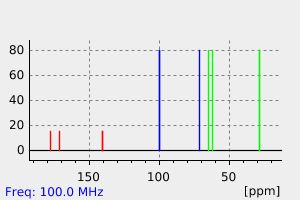4-((2,3-dihydrothieno[3,4-b][1,4]dioxin-2-yl)-methoxy)-4-oxobutanoic acid | 146796-03-4
中文名称
——
中文别名
——
英文名称
4-((2,3-dihydrothieno[3,4-b][1,4]dioxin-2-yl)-methoxy)-4-oxobutanoic acid
英文别名
4-((2,3-dihydrothieno[3,4-b][1,4]dioxin-2-yl)methoxy)-4-oxobutanoic acid;Vygxtygryvrjkl-uhfffaoysa-;4-(2,3-dihydrothieno[3,4-b][1,4]dioxin-3-ylmethoxy)-4-oxobutanoic acid
CAS
146796-03-4
化学式
C11H12O6S
mdl
——
分子量
272.279
InChiKey
VYGXTYGRYVRJKL-UHFFFAOYSA-N
BEILSTEIN
——
EINECS
——
-
物化性质
-
计算性质
-
ADMET
-
安全信息
-
SDS
-
制备方法与用途
-
上下游信息
-
文献信息
-
表征谱图
-
同类化合物
-
相关功能分类
-
相关结构分类
物化性质
-
沸点:451.2±45.0 °C(Predicted)
-
密度:1.410±0.06 g/cm3(Predicted)
计算性质
-
辛醇/水分配系数(LogP):0.7
-
重原子数:18
-
可旋转键数:6
-
环数:2.0
-
sp3杂化的碳原子比例:0.45
-
拓扑面积:110
-
氢给体数:1
-
氢受体数:7
上下游信息
-
上游原料
中文名称 英文名称 CAS号 化学式 分子量 羟甲基 EDOT (2,3-dihydrothieno[3,4-b][1,4]dioxin-3-yl)methanol 146796-02-3 C7H8O3S 172.205 2-(氯甲基)-2,3-二氢-噻吩并[3,4-b]-1,4-二噁英 2-chloromethyl-2,3-dihydrothieno[3,4-b][1,4]dioxine 857419-46-6 C7H7ClO2S 190.65
反应信息
-
作为反应物:描述:4-((2,3-dihydrothieno[3,4-b][1,4]dioxin-2-yl)-methoxy)-4-oxobutanoic acid 、 丙酮缩甘油 在 4-二甲氨基吡啶 、 N,N'-二环己基碳二亚胺 作用下, 以 二氯甲烷 为溶剂, 反应 24.0h, 以68%的产率得到((2,3-dihydrothieno[3,4-b][1,4]dioxin-2-yl)methyl) ((2,2-dimethyl-1,3-dioxolan-4-yl)methyl) succinate参考文献:名称:通过使用硼酸酯化学可切换的表面润湿性。摘要:在这里,我们首次报告了硼酸酯作为可逆表面后功能化的有效工具的使用。硼酸酯键使表面可逆地从亲水性转变为疏水性。基于众所周知的硼酸/乙二醇亲和力,该策略可通过将各种硼酸添加到带有乙二醇基团的底物上来提供发挥表面疏水性的机会。然后可以逆转后官能化以再生起始的乙二醇表面。该途径允许制备各种可切换表面,以用于生物传感器,液体运输和分离膜的广泛应用。DOI:10.1002/cphc.201500873
-
作为产物:描述:2-(氯甲基)-2,3-二氢-噻吩并[3,4-b]-1,4-二噁英 在 4-二甲氨基吡啶 、 水 、 三乙胺 、 sodium hydroxide 作用下, 以 二氯甲烷 、 二甲基亚砜 为溶剂, 生成 4-((2,3-dihydrothieno[3,4-b][1,4]dioxin-2-yl)-methoxy)-4-oxobutanoic acid参考文献:名称:Electrochemical sensor based on f-SWCNT and carboxylic group functionalized PEDOT for the sensitive determination of bisphenol A摘要:A simple, sensitive, and reliable method for the voltammetric determination of bisphenol A (BPA) by using carboxylic group functionalized single-walled carbon nanotubes (f-SWCNT)/carboxylic-functionalized poly(3,4-ethylenedioxythiophene) (PC4) complex modified glassy carbon electrode (GCE) has been successfully developed. The electrochemical behavior of BPA at the surface of the modified electrode is investigated by electrochemical techniques. The cyclic voltammetry results show that the as-prepared electrode exhibits strong catalytic activity toward the oxidation of BPA with a well-defined anodic peak at 0.623 V in PBS (0.1 mol/L, pH 7.0). The surface morphology of the 3D network of composite film is beneficial for the adsorption of analytes. Under the optimized conditions, the oxidation peak current is proportional to BPA concentration in the range between 0.099 and 5.794 mu mol/L (R-2 = 0.9989), with a limit of detection of 0.032 mu mol/L (SIN = 3). The enhanced performance of the sensor can be attributed to the excellent electrocatalytic property of f-SWCNT and the extraordinary conductivity of PC4. Furthermore, the proposed modified electrode displays high stability and good reproducibility. The good result on the voltammetric determination of BPA also indicates that the asfabricated modified electrode will be a good candidate for the electrochemical determination and analysis of BPA. (C) 2013 Xue-Min Duan. Published by Elsevier B.V. on behalf of Chinese Chemical Society. All rights reserved.DOI:10.1016/j.cclet.2013.12.020
文献信息
-
Electrically Conducting Polymers申请人:Ying Jackie Y.公开号:US20100048815A1公开(公告)日:2010-02-25The present invention provides a polymer for use in detecting or quantifying an analyte Exposure of the polymer to the analyte is capable of causing a shift in the onset potential for conductivity or semiconductivity of the polymer. A sensor for an analyte comprising the polymer is also described.
-
US8114955B2申请人:——公开号:US8114955B2公开(公告)日:2012-02-14
-
[EN] ELECTROCHEMICAL SENSORS<br/>[FR] DETECTEURS ELECTROCHIMIQUES申请人:UNIV LIVERPOOL公开号:WO2006018643A2公开(公告)日:2006-02-23The present invention relates to an electrochemical sensor comprising at least one conjugate having a ligand attached to 3,4-ethylenedioxythiophene (EDOT) or derivative or polymer thereof by means of a spacing element, said ligand being capable of binding a target molecule in a sample, and said EDOT being attached to an electrode such that the binding of a target molecule to the ligand results in a detectable change in the electrochemical properties of the conjugate on the electrode. The sensor is particularly useful for testing biological and chemical material within samples.
-
[EN] POLYMERIC FILMS<br/>[FR] FILMS POLYMÈRES申请人:AGENCY SCIENCE TECH & RES公开号:WO2008130326A1公开(公告)日:2008-10-30[EN] The present invention relates to an electrically conductive polymeric film. The polymer of the film comprises monomer units selected from the group consisting of ethylendioxythiophene, derivatives of ethylendioxythiophene and mixtures thereof. The film is ultrasmooth, and may have a surface root-mean-square roughness Rrms of less than about 10nm.
[FR] La présente invention porte sur un film polymère conducteur de l'électricité. Le polymère du film comprend des unités monomères choisies dans le groupe constitué par l'éthylènedioxythiophène, les dérivés d'éthylènedioxythiophène et leurs mélanges. Le film est ultra-lisse, et peut avoir une profondeur moyenne quadratique de rugosité de surface Rrms de moins d'environ 10 nm.
表征谱图
-
氢谱1HNMR
-
质谱MS
-
碳谱13CNMR
-
红外IR
-
拉曼Raman
-
峰位数据
-
峰位匹配
-
表征信息
同类化合物
(反式)-4-壬烯醛
(s)-2,3-二羟基丙酸甲酯
([1-(甲氧基甲基)-1H-1,2,4-三唑-5-基](苯基)甲酮)
(Z)-4-辛烯醛
(S)-氨基甲酸酯β-D-O-葡糖醛酸
(S)-3-(((2,2-二氟-1-羟基-7-(甲基磺酰基)-2,3-二氢-1H-茚满-4-基)氧基)-5-氟苄腈
(R)-氨基甲酸酯β-D-O-葡糖醛酸
(5,5-二甲基-2-(哌啶-2-基)环己烷-1,3-二酮)
(2,5-二氟苯基)-4-哌啶基-甲酮
龙胆苦苷
龙胆二糖甲乙酮氰醇(P)
龙胆二糖丙酮氰醇(P)
龙胆三糖
龙涎酮
齐罗硅酮
齐留通beta-D-葡糖苷酸
鼠李糖
黑芥子苷单钾盐
黑海棉酸钠盐
黑木金合欢素
黑曲霉三糖
黑介子苷
黄尿酸8-O-葡糖苷
麻西那霉素II
麦迪霉素
麦芽糖脎
麦芽糖基海藻糖
麦芽糖1-磷酸酯
麦芽糖
麦芽四糖醇
麦芽四糖
麦芽十糖
麦芽六糖
麦芽五糖水合物
麦芽五糖
麦芽五糖
麦芽五糖
麦芽三糖醇
麦芽三糖
麦芽三糖
麦芽三塘水合
麦芽七糖水合物
麦芽七糖
麦法朵
麦可酚酸-酰基-Β-D-葡糖苷酸
麦利查咪
麝香酮
鹤草酚
鸢尾酚酮 3-C-beta-D-吡喃葡萄糖苷
鸡矢藤苷







